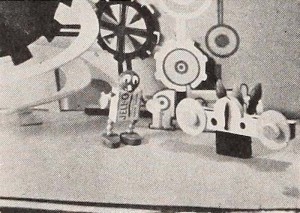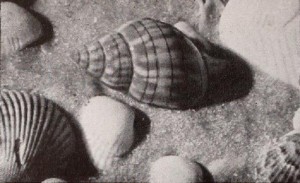"The film begins at a women's hairdressers. The manager asks one of the hairdressers to dinner that evening but she refuses as she has a customer, Mrs Blowers, who requires longer visits. At this the manager appoints Jane, a fellow hairdresser to take the appointment. Jane looks at the portrait of her fiance. We follow as the portrait dissolves into the real man. He works with cars and is informed that he has lost his job. Back at the hairdressers and Mrs Blowers arrives for her appointment. What starts as 'just a trim' becomes a longer matter. The clock shows 7.15 PM, closing time at the hairdressers. Jane loses her temper with her customer and insults her. The woman responds, stating that she will be making a complaint. On her way out Jane is informed that her customer was a stakeholder in the business. Jane meets with her boyfriend and they agree to share their bad news at a café. Later Jane discusses her situation with her friend but still despairs at her predicament. We see her writing a letter to her fiance, returning his ring and ending their engagement. She posts the letter. The next day at work Jane is informed of her week's notice. She begins cutting a young girl's hair. Outside one of the employees has alerted all about a fire. Jane notices smoke at her door. She covers the child and carries her out of the building but collapses from the smoke. The next sequence shows her in hospital. She is visited by her boyfriend and we see that she is wearing her engagement ring. At home recovering, she is visited by Mrs Blowers. This is where the film ends abruptly" (MACE Online Archive).
"'Japan and Its People,' Dr. Roy Gerstenkorn's educational class winner, was a pictured visit to the homes and temples of Japan. Ignoring the cities in his search for the story of the Japan that is not known to the average visitor the doctor penetrated the towns and smaller communities. His picture was awarded a high rating on its photography as well as on his treatment of the subject. After the showing of this picture before the Los Angeles Motion Picture Forum last summer the local school authorities requested and received permission from the doctor to make a duplicate of it for school purposes." American Cinematographer, Jan. 1938, 27-28.
"Ship sails from Chicago, visits Japan's ports, cities, villages, etc. Views of modern with traditional." UC San Diego Library.
Jazzflections is a sound and color blending film by Leon Paquette of Lynn, Mass. It's 2½ minutes of experimenting in how music looks color-wise and shape-wise. It's short enough to be entertaining and yet long enough to let you know how some other guy feels about the sound of music," PSA Journal, Mar. 1970, 44.
"Jeannie is the little girl in the house where too much of the family income is spent for purposes other than family. With the aid of the court Jeannie is assigned to a Home where she can have the things she needs and toys and playmates. Perhaps we all know the story but each one tells it differently, arriving at a happy ending. The foundation of this club production was a publicity film which it made and donated to the Home" PSA Journal, Nov. 1959, 48.
"'Jeep Trails Through Utah' was produced by Stan Midgley with the use of a jeep rather than his faithful bicycle. He had to leave his bicycle at home, as the deep sands of Utah can only be traveled in a jeep. In his mechanical horse he criss-crossed one of the emptiest blanks on the American map. He leaves the traveled highways and goes back into the little known areas to find fantastically beautiful and unusual natural formations. He travels over sand-blown desert trails, up rocky mountain paths and through treacherous mountain gorges to produce a gem-like picture of Utah." La Canada Valley Sun, Sept. 9, 1971.

"Jello Again is an entertaining film, produced entirely by animation, that stands by itself even when the special work necessary to produce it is discounted. This Kodachrome subject, filmed by Carl Anderson, is made entirely in stop motion with puppet actors, an exceedingly difficult job. The excellence of the handling of the puppets and accessory properties, together with the imaginative quality of the settings, makes the subject an outstanding one. Here and there throughout the film, there are certain indications of unevenness in exposure on the "over" side, but, because of the real achievement embodied in the film as a whole, this very slight flaw may well be overlooked. The models used in the action were most cleverly constructed and colored, and the variety of camera angles employed was especially appropriate to the subject from the point of view of presenting the material advantageously." Movie Makers, Dec. 1939, 634.
"Renowned Hungarian violinist Jelly D'Aranyi steals the scene, and brings a swirl of glamour to a cold Manchester day, as she entertains young Ruth Behrens in the family's garden. Jelly always stayed at Holly Royde, the Behrens' family home, when she performed with the Halle Orchestra. Look out for Ruth's sister Mary, confined to the house with a cold, and watching the fun through opera glasses." (BFI Player)
"Jerusalem . . . Center of Many Worlds was voted the best Class C film of the year. Mr. J. Hagopian of Atlantic Productions, Thousand Oaks, Calif., takes us on a very thorough tour of Jerusalem not only from the standpoint of tourist interests but through the history of Jerusalem as well. This approach is a hard one to handle, but Mr. Hagopian has done it skillfully and in an entertaining matter. This 29-minute trip through the Holy Land is an absorbing one, and you will come away knowing more about that part of the world than most of us have expected to know," PSA Journal, Mar. 1970, 43.

"You may have wandered idly along the seashore and picked up an attractive seashell, but, unless you are a conchologist, you will never know how far an interest in shells will carry you, until you have seen Jewels of the Sea, by W. W. Vincent, jr. This film is a story of collecting seashells. It tells, with freshness and enthusiasm, how shells are discovered on the shore, how they are cleaned and prepared for preservation and how they are studied. On the west coast of Florida, we see hunters searching for specimens ; we visit a shell shop and the home of a collector. The camera, plus color film, reveals the beauty of the specimens and presents intriguing mysteries, for some of the shells were built by mollusks that have never been seen alive. The source of their irridescent beauty is entirely unknown. Jewels of the Sea does not pretend to be an educational film about zoology, but it is informative as well as entertaining, and it is distinguished by flawless camera work." Movie Makers, Dec. 1943, 457, 474.
Total Pages: 203